Department Clinical Sciences Nutrition
Introduction
Health care professionals have shown an increasing interest in developing strategies to in cooperate robust nutritional information into national information systems. These methods tend to evaluate nutritional policies and tackle incidences of malnutrition globally. As such, the validity of what people drink or eat regardless of their amount preferences generates significant information and evidence, which contributes to nutritional programs besides enhancing consumer education. The data of what people eat, and drink may be collected in three different bases: From an individual, national or household level. Individual methods such as keeping of food records, 24- hour dietary recalls, food habit questionnaires, food frequency questionnaires and diet histories prove to be most efficient. In this essence, dietary assessments methods both direct and indirect are often applied to improve the quality of nutrition information collected from an individual or population (Food and Agricultural Organization of the United Nations, 2018). These procedures evaluate dietary patterns and nutritional intake of a person or a group of people over a specific period of time. Moreover, selecting an appropriate dietary assessment technique generates better evidence that is used to recommend effective nutrition policies. For those pursuing research in this area, accessing healthcare dissertation help can provide valuable insights and support in developing comprehensive studies.

Objective
This study aims to analyse an individual’s nutrition intake for a week and formulate an adequate diet requirement program to ensure a healthy lifestyle.
METHODOLOGY
The study sampled the dietary patterns of a 49-year-old woman, for seven days using the direct prospective dietary assessment method on a weighted food intake record to increase the accuracy of the habitual dietary intake.
The dietary habits were then recorded in a food diary, which accounted for her meal time, type of food, and the portion size of her foods and drinks.
The Subject recorded to be allergic to peanut and red raw onions, she also recorded to be taking supplements; Vitamin C; Magnesium Citrate; Vitamin D (oral) and Zinc. The average daily energy, macronutrient, and micronutrient intakes were then calculated using the Nutritics Software and results obtained as depicted (See Appendix) A questionnaire was also given to determine anthropometric data, that is, height and weight to determine her basal metabolic rate (BMR) Portion sizes may be determined by weighing or by approximating volumes using visual aids such as images.
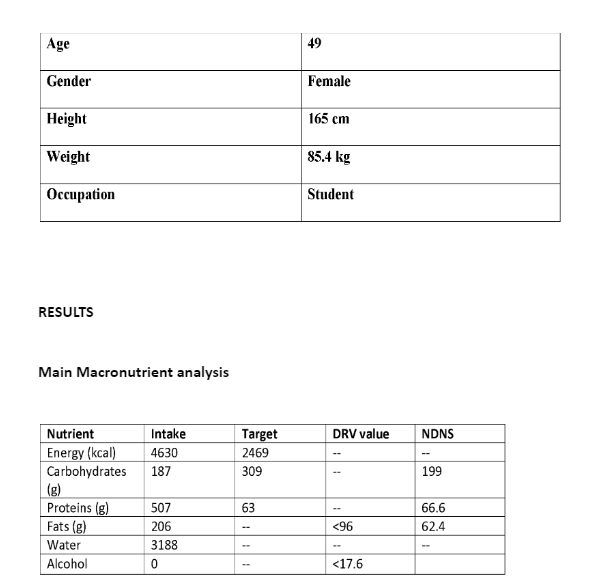
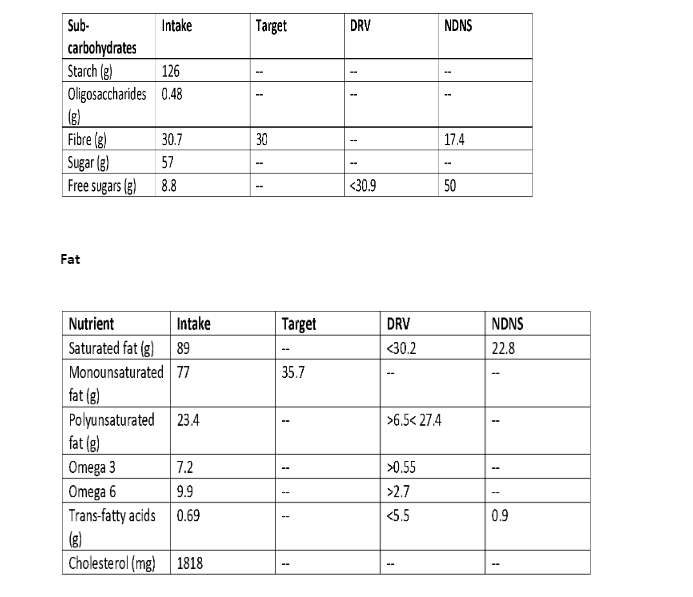
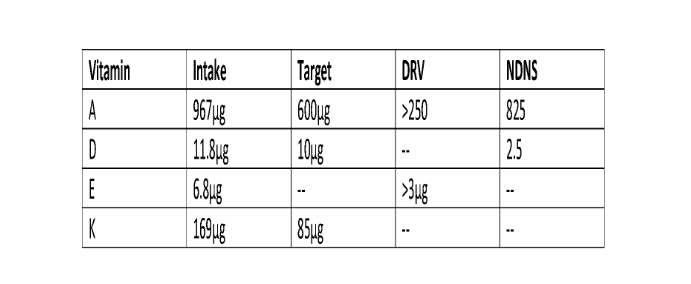
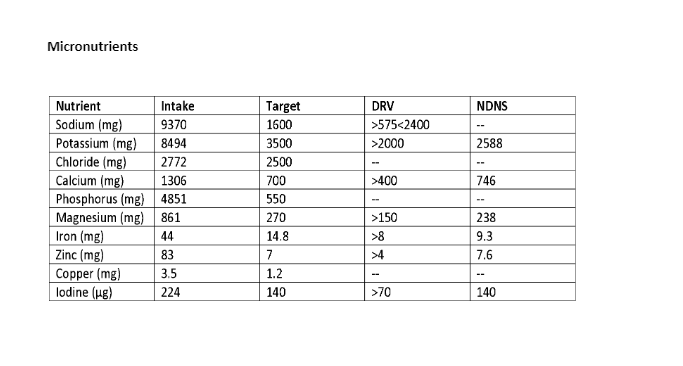
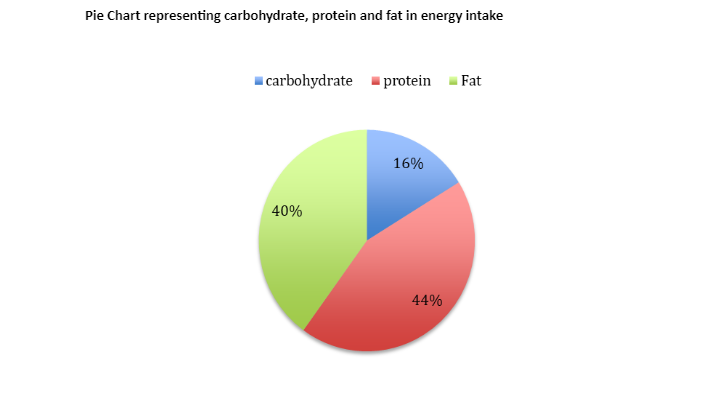
Generally, the study results present poor dietary habits of the test subject and nutritional risks. In relation to subject’s personal information, she is regarded as obese since her BMI is over 30 while at the age of 49. In addition, her nutrition intake is imbalanced. For instance, the Nutritics software indicates that subject’s average calorie intake is 4630 kcal, a value beyond her dietary reference value of 2469 kcal. Also, the amount of fatty foods she consumes of 206g surpasses the recommended dietary limits of below 96g. On the other hand, the Macronutrient analysis shows excessive consumption of proteins in our test subject diet with 43.8 percent and high portions of fats of 40 percent in contrast to the significantly low quantities of Carbohydrates of 16.2 percent. These demographics clearly seem to contribute to her present obese condition and may risk incidences of cardiovascular diseases such as hypertension. Nevertheless, the Subject’s water intake levels of 3188g seem recommendable since biological bodily functions and maintenance tend to demand higher water activity.
Dietary fat is a crucial source of energy in the body since it facilitates the absorption of other dietary components like vitamins. Moreover, cholesterol and fatty acids are involved in various metabolic processes in the body like forming structural components of the cell membrane and enzyme activity regulation. Nevertheless, high-fat diets tend to compromise insulin sensitivity and reverse the function of postprandial factor VII thus enhance incidences of cardiovascular risks besides other chronic condition like type 2 diabetes and obesity.
According to (Carbohydrates) the prevalence of obesity in the states is quite high. For instance, in England the prevalence of obesity in men was estimated to increase from 13.2 percent in 1993 to 24.4 percent in 2012 and 16.4 percent in women to 25.1 percent. This condition occurs when the amount of energy intake or calories consumed from food and drinks is higher than the energy expended through biological processes and physical activity. That is to say, obesity is a consequent of fat accumulation within the body muscles over time. For example, the subject’s high mean fat intake of 40 percent compromises her health besides. Also, the food diary records several meals with saturated fat content like pancakes, fries, and roasted chicken yet with exercise of 2-3 times a week. This unbalanced use of energy increases an individual’s chance of experiencing hypertension since accumulation of fat in the body muscles prevents sufficient flow of oxygen.
Other health outcomes like weight gain are associated with additional dietary protein intake in children and adults. (European Food Safety Authority (EFSA), 2017) The food consumption surveys suggest that the mean protein intake among adults in Europe is 0.83g/kg body weight per day; however, most individuals record 17-27 E%. The reference nutrient requirement of protein intake in adults in a day is set at 0.75g of protein per kilogram bodyweight. That is to say, the nutrient respiratory quotient multiplied by the subject’s body weight. For instance, a person’s protein intake may be validated as 49kg multiplied by 0.75 (49*0.75 = 36.75g) giving a nutrient requirement of 36.75g daily. All the same researchers claim to need more data in order to determine an indispensable protein requirement.
Take a deeper dive into The Intervention Of Healthy Diet And Nutrition In Managing with our additional resources.
Carbohydrates are a major source of energy and include various carbon compounds. The major forms are known to be simple sugars, oligosaccharides, and polysaccharides. However, nutritionists approve them based on their digestion and absorption capability in the small intestine (Jones, Peña, Korczak and Braun, 2015). That is, digestible carbohydrates that are absorbed and digested easily and non-digestible carbohydrates that are resistant to hydrolysis hence absorbed in the colon (fibres).
The most important high dietary intake associated with salt is sodium, particularly found in sodium chloride with sodium accounting for 40 percent and chloride being 60 percent. Sodium is also present in plants, animals, and purified drinking water (SACN, 2015). It is estimated that about 15 – 20 percent of dietary salt intake is from discretionary sources while 15 percent is from unprocessed foods and manufactured foods contribute 65 – 70 percent. Likewise, cereal and cereal products contribute averagely 40 percent intake and meat and meat products are 21 percent intake. The national survey data claim that adults salt intake in a day is 173 mmol for men and 132 mmol for women (SACN, 2015). On the other hand, the dietary value reference reports recommend a lower reference nutrient of 0.6g/24 mmol sodium and a reference nutrient intake of 1.6g/70 mmol sodium per day.
Nonetheless, high salt intake beyond the recommended dietary reference values is often associated with blood pressure and hypertension since salts control the forces that drive the circulatory system. According to SACN (2015) primary hypertension is responsible for over 90 percent clinical cases. For instance, in 2001 the Health Survey for England confirmed the prevalence of high blood pressure to be 41 percent for men and 35 percent for women. These figures later increased with age to 70 percent in men and 79 percent in women. Also, the Scottish Health Survey in 1998 recorded an overall prevalence of hypertension of 33 percent in men and 28 percent in women, which increased to 74 percent in men and 76 percent in women. Similarly, factors like obesity, excessive alcohol consumption, and physical inactivity tend to contribute to hypertension (SACN, 2015).
Iron is an essential component of the haemoglobin in red blood cells. The nutrient facilitates the distribution of oxygen and its storage in muscle tissues. Iron also forms part of the integral enzymes that enhance energy metabolism, protein synthesis, hormones, and neurotransmitters. The DRVs for iron intake estimate the iron status, which describe whether an individual has too little or too much iron in the body. For instance, the Guidance Level for supplemental intake of iron is 17mg per day for adults in the United Kingdom (Geissler and Singh, 2011). Dietary iron mostly exists in non-haem food supplements such as cereals, vegetables, eggs, and red meat. In fact, 100 g of cooked red meat has about 0.5 to 30 mg 10. In relation to our dietary assessment results, the participant recorded high iron intake of 44 g per day. This is a higher iron intake in contrast to the DRV of less than 8 g per day. Moreover, the subject’s food diary showed significantly high protein intake from red meat. The Nutritional Aspects of the Development of Cancer and the Committee on Medical Aspects of Food and Nutrition Policy (COMA) reports linked possible health effects of colorectal cancer with red and processed meat, which are high in iron content (Geissler and Singh, 2011). In addition, iron is known for its high affinity for oxygen hence acute high doses may damage the intestinal mucosa and cause systemic shock or death. On the other hand, COMA’s recommendation to reduce meat consumption compromises other dietary sources of other micronutrients like iron and vitamin B hence the subject needs to be reviewed.
Most research demographics associate poor dietary habits with materially deprived populations. A survey of household income in NDNS revealed that adults between 19-64 years with low incomes consumed a higher percentage of energy from total carbohydrates than did the highest nutritious carbohydrate foods. A prime example, the mean NMES intake was confirmed to be higher with 12.7 percent total dietary energy as compared to the highest nutritious carbohydrates with 10 percent. In addition, a vivid income gradient in lower non-starch polysaccharides intake was also noted among low income adults (Nisar et al., 2016). That is to say, these individuals could hardly afford nutritious meals with fruits and vegetable components thus consuming dietary foods below the DRV and assuming their nutrition requirements.
Furthermore, the Family Food Survey on household purchases revealed that the proportion of energy foods in household diets was highest among lowest income individuals in contrast to non-starch polysaccharide contents. Moreover, the United Kingdom low income and nutrition survey conducted in 2003 – 2005 confirmed that carbohydrate intake was significantly higher among the low-income population (SACN, 2015). Evidently, these demographics ascertain that poorly processed foods are cheaper in the market hence more affordable as compared to a nutritious diet.
The diverse ethnic groups in the United States present various traditional healthcare practices besides those recommended from the state’s healthcare systems. The different cultures present their beliefs in different ways, particularly in their dietary patterns and nutritional lifestyle. African Americans experience dietary problems since most of them are often diagnosed with chronic diseases such as obesity, hypertension, and diabetes. (Nnakwe, 2012) Historically, this native group place a higher esteem in their traditional food aspects called the “Soul food”, which had a major characteristic of high fat, salt, and sugar contents. The “Soul food” was majorly prepared to celebrate New Year’s and marked a sign of good luck in the upcoming year. For instance, 49.5 percent of the black individuals rated their overall diet to be high in fat, sugar, and cholesterol elements due to their low income, which could afford such meals (Mesman et al, 2016). Also, hypertension was the common health condition affecting them with a 24.6 percent incidence rate. Most drinks and deserts of these people are heavily sweetened, and butter is used in the preparation of side dishes like yams (St Rose and Wilson, 2009).
Despite prospective dietary assessment method being preferred as a convenient method to assess individuals or a community nutrition habits, the method proves inconvenient in some research circumstances. Firstly, the direct prospective model requires multi-day recalls of one’s diet in order to account for the habitual nutrient intake of the subject and record seasonality differences or recall bias may be present. For instance, a negative bias for energy and nutrient intake in a multiple-pass recall in rural Ethiopian women was confirmed when the median estimates from their food records were registered (Food and Agricultural Organization of the United Nations, 2018). Also, the method is quite expensive since it requires extensive training for the interviewers and the time spent on data entry and food matching with food composition data. For example, the macronutrient data analysis demands input of matching food composition data, which is tiresome since some foods nutritional contents are not known or has little research hence one may assume the data (Food and Agricultural Organization of the United Nations, 2018).
Continue your journey with our comprehensive guide to Demographics and Patient Professional Dynamics in.

References
- European Food Safety Authority (EFSA). (2017). Dietary Reference Values for nutrients Summary report. EFSA Supporting Publications, 14(12), e15121E.
- Food and Agricultural Organization of the United Nations (2018). Dietary Assessment: A resource guide to method selection and application in low resource settings. Rome.
- Jones, J. M., Peña, R. J., Korczak, R., & Braun, H. J. (2015). CIMMYT series on carbohydrates, wheat, grains, and health: carbohydrates, grains, and wheat in nutrition and health: An Overview. Part I. Role of carbohydrates in health. Cereal Foods World, 60(5), 224-233.
- Mesman, J., van IJzendoorn, M. H., & Sagi-Schwarz, A. (2016). Cross-cultural patterns of attachment. Handbook of Attachment: Theory, Research, and Clinical Applications, third ed. Guilford, New York, NY, 852-877.
- Nisar, M. U., ul Haq, M. M. A., Tariq, S., Anwar, M., Khawar, A., Waqas, A., & Nisar, A. (2016). Feeding patterns and predictors of malnutrition in infants from poor socioeconomic areas in Pakistan: A Cross-Sectional Survey. Cureus, 8(1).
- Nnakwe, N. (2012). Community nutrition: Planning Health Promotion and Disease prevention. Jones & Bartlett Publishers.
- Roberts, C., Steer, T., Maplethorpe, N., Cox, L., Meadows, S., Nicholson, S., & Swan, G. (2018). National Diet and Nutrition Survey: Results from Years 7 and 8 (combined) of the Rolling Programme (2014/2015–2015/2016).
- Geissler, C., & Singh, M. (2011). Iron, meat and health. Nutrients, 3(3), 283-316.
- St Rose, M., & Wilson, R. (2009). Chronic diseases among African Americans in Southeastern Virginia: a pilot study. Journal of Nursing and Healthcare of Chronic Illness, 1(2), 156-166.
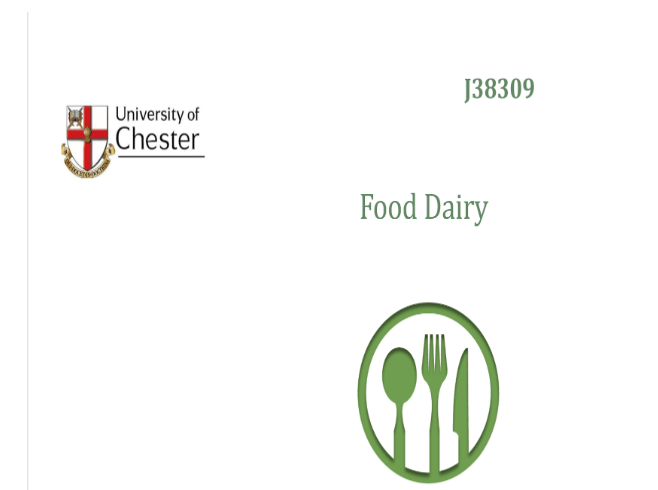
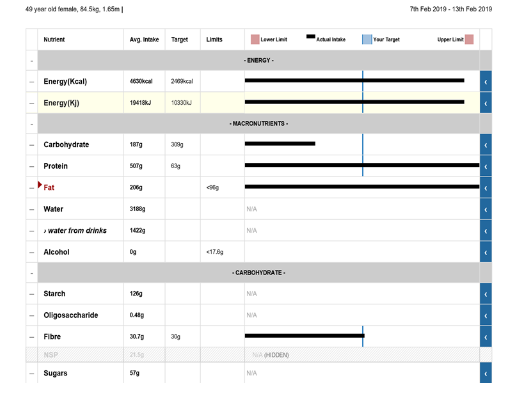
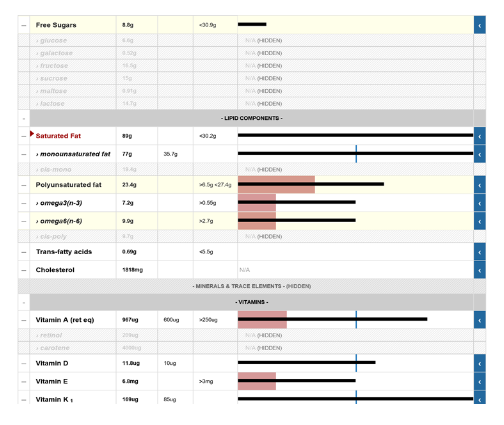
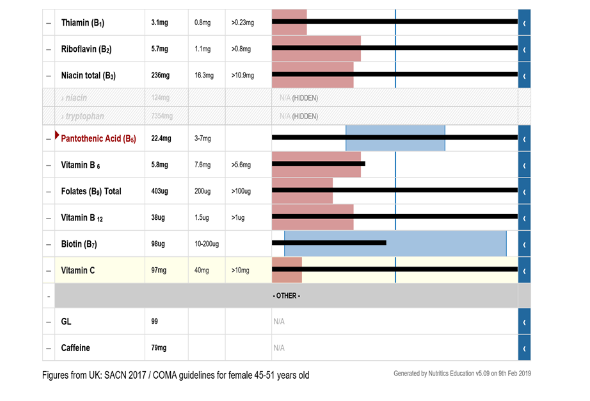
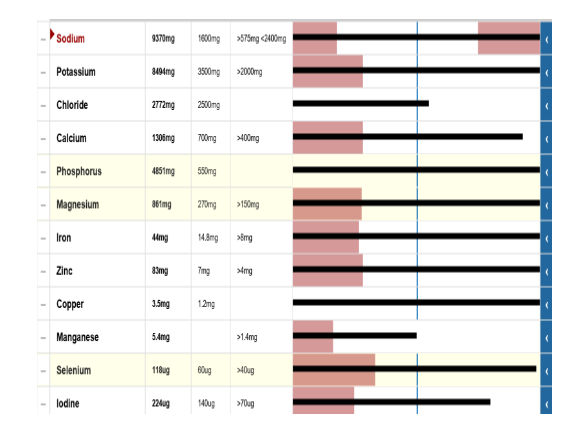

- 24/7 Customer Support
- 100% Customer Satisfaction
- No Privacy Violation
- Quick Services
- Subject Experts



